History of Thai clothing
Thai traditional costumes vary by city and the ruler of each historical period.[1] Thai clothes can be classified according to six distinct periods of history; beginning with the 11th Buddhist century.[2] Previously, traditional Thai clothes were worn daily; however, they are now only worn on auspicious functions such as Thai traditional marriage ceremonies.
Dvaravati
Dvaravati began in Buddhist century 11-16.[3] During this period the north city Dvaravati ruled the country. The style was influenced by the Indian style that used colored stones as accessories.[4] Men's clothes during that time the pants were similar to Indian loincloths with a silk top or no top. Accessories were golden necklaces and metal belts. On women's clothes the tops were usually one cloth brace on the shoulder or tightly wrapped around the breasts with a long skirt from waist to ankle. Accessories were similar to those of the men.
Lopburi
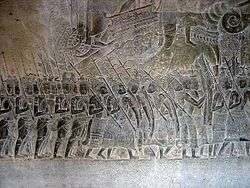
Lopburi started at the end of Buddhist century 16-19. This period was ruled by the Lopburi.[5] Fashion was influenced by the Khmer.[6] Men's clothes were short sarongs worn tight around the waist about knee length with a metal belt. Women's clothes were sometimes without top or a cloth wrapping the breasts, with a short sarong. Both ends of the sarong came together in the front to look like a stripe.
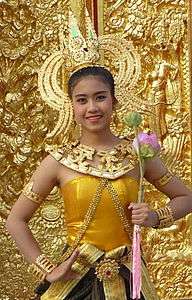
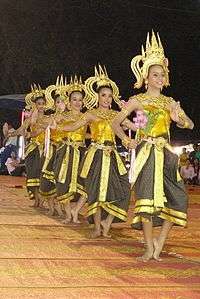 Thai dancer with the Lopburi style clothing.
Thai dancer with the Lopburi style clothing.
Sukhothai
Sukhothai became the fashion in Buddhist century 19-20. The city of Sukhothai united the cities which were ruled by different kings.[5] Men's clothing was a simple full sleeved top with a long V shape neck and a cloth brace on their shoulders. The loincloth was made of silk with a big metal or golden belt. Women's clothing was a long silk sarong with flowers painted on it. The top normally is a full sleeved silk cloth. Married women wore one cloth wrapped around the breasts made of silk or other fabric.[7]
Ayutthaya

Ayutthaya was the style during the end of Buddhist century 19-21. Ayutthaya was the capital for 417 years, the longest period since Thailand was under one king.[8] Many styles followed the period of Ayutthaya but they changed frequently, under the influence of many countries and are not considered traditional.
Historically, both Thai males and females dressed themselves with a loincloth wrap called chong kraben. Men wore their chong kraben to cover the waist to halfway down the thigh, while women covered the waist to well below the knee.[9] Bare chests and bare feet were accepted as part of the Thai formal dress code, and is observed in murals, illustrated manuscripts, and early photographs up to the middle of the 1800s.[9] In the royal court, royalty and nobility men are wearing lomphok, a tall pointed hat, made of white cloth wrapped around a bamboo frame, and Khrui, a light outer garment worn as a gown or robe in certain ceremonial settings. Traditional Thai attire has changed significantly throughout the Rattanakosin period.[10]
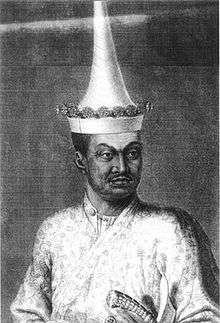
- Kosa Pan wearing lomphok and Khrui, 1686.
 Claude de Forbin wearing Ayutthayan mandarin dress.
Claude de Forbin wearing Ayutthayan mandarin dress.
Rattanakosin
Old Rattanakosin
Early Rattanakosin central Thai dressed as same as Ayutthaya period, however, after the Second Fall of Ayutthaya and repeated Burmese invasions, central Thai women began cutting their hair in a crew-cut short style, which remained the national hairstyle until the 1900s.[11] Prior to the 20th century, the primary markers that distinguished class in Thai clothing were the use of cotton and silk cloths with printed or woven motifs, but both commoners and royals alike wore wrapped, not stitched clothing.[12]
Men clothing
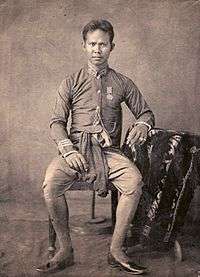 Prince Yodyingyot, later Bowon Wichaichan with Old Rattanakosin style clothing.
Prince Yodyingyot, later Bowon Wichaichan with Old Rattanakosin style clothing.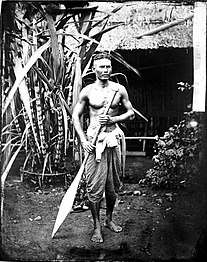 Clothing of Thai boatman, holding an oar.
Clothing of Thai boatman, holding an oar.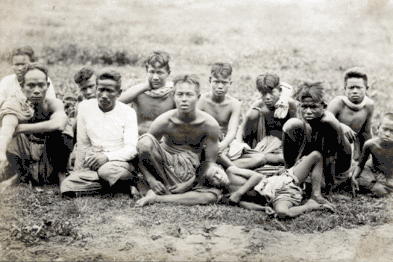 Thai men squat with Old Rattanakosin style clothing.
Thai men squat with Old Rattanakosin style clothing.
Women clothing
 Queen Savang Vadhana, a consort and half-sister of King Chulalongkorn (Rama V).
Queen Savang Vadhana, a consort and half-sister of King Chulalongkorn (Rama V).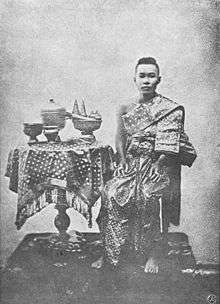 Queen Debsirindra, the second consort of King Mongkut with Old Rattanakosin style clothing, 1855.
Queen Debsirindra, the second consort of King Mongkut with Old Rattanakosin style clothing, 1855.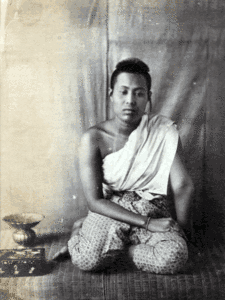 Thai woman portrait with Old Rattanakosin style clothing.
Thai woman portrait with Old Rattanakosin style clothing.
Modern Rattanakosin
From the 1860s onward, Thai royals "selectively adopted Victorian corporeal and sartorial etiquette to fashion modern personas that were publicized domestically and internationally by means of mechanically reproduced images."[12] Stitched clothing, including court attire and ceremonial uniforms, were invented during the reign of King Chulalongkorn.[12] Western forms of dress became popular among urbanites in Bangkok during this time period.[12] During the early 1900s, King Vajiravudh launched a campaign to encourage Thai women to wear long hair instead of traditional short hair, and to wear pha sinh (ผ้าซิ่น), a tubular skirt, instead of the chong kraben (โจงกระเบน), a cloth wrap.[13]
Men clothing
 King Chulalongkorn wearing the raj pattern costume, consisting of a white Nehru-style jacket with five buttons and a chong kraben.
King Chulalongkorn wearing the raj pattern costume, consisting of a white Nehru-style jacket with five buttons and a chong kraben.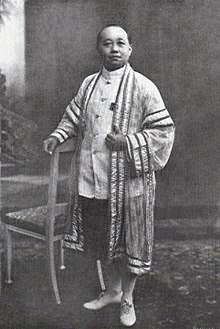 King Vajiravudh wearing the raj pattern covered with the khrui.
King Vajiravudh wearing the raj pattern covered with the khrui.
Women clothing
Fascist Thailand
On 15 January 1941, Plaek Pibulsonggram issued a Thai cultural mandate to modernize and westernize Thai dress, by deeming long-practiced customs of wearing underpants, wearing no shirt, or wearing a wraparound cloth, as forms of inappropriate public attire.[14]
Contemporary Thai clothing
The formal Thai costume, known in Thai as ชุดไทยพระราชนิยม (RTGS: chut thai phra ratcha niyom, literally Thai dress of royal endorsement), includes several sets of dress, designed as the Thai national costume in formal occasions. Although described and intended for use as national costume, they are of relatively modern origins, having been conceived in the second half of the 20th century.
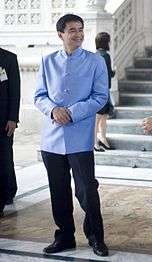 Former Thai Prime Minister Abhisit Vejjajiva wearing the chut thai phra ratcha niyom
Former Thai Prime Minister Abhisit Vejjajiva wearing the chut thai phra ratcha niyom
See also
References
- ↑ Silahorm, kanokporn, kanhittha et al (2007),Thai Costume(In thai).
- ↑ Bangkok studio. History of Thai Traditional Clothes(In thai).
- ↑ Hanisah (November, 2007)(In thai).
- ↑ Bangkok studio. Tavaravadee Clothes(In thai).
- 1 2 baanjomyut.com (august, 2001)(In thai)
- ↑ Ohm Ratchavej (2000)The Thai History. Amarin(In thai)
- ↑ Chayada (2009),thaigoodview.com(In thai)
- ↑ Thailand Knowledge Center (March 2012),The costume of Ayutthaya(In thai)
- 1 2 Terwiel, Barend Jan (2007). "The Body and Sexuality in Siam: A First Exploration in Early Sources" (PDF). Manusya: Journal of Humanities (14): 42–55.
- ↑ Mayusoh, Chanoknart (2014). "Formal Thai National Costume in the Reign of King Bhumibol Adulyadej". International Journal of Social, Behavioral, Educational, Economic, Business and Industrial Engineering. World Academy of Science, Engineering and Technology.
- ↑ Jotisalikorn, Chami (2013). Thailand's Luxury Spas: Pampering Yourself in Paradise (in cj). Tuttle Publishing. p. 183.
- 1 2 3 4 Peleggi, Maurizio (2010). Mina Roces, ed. The Politics of Dress in Asia and the Americas. Sussex Academic Press,. ISBN 9781845193997.
- ↑ Sarutta (10 September 2002). "Women's Status in Thai Society". Thaiways Magazine. Retrieved 7 November 2016.
- ↑ The Royal Gazette, Vol. 58, Page 113. January 21, B.E. 2484 (C.E. 1941). Retrieved on June 4, 2010.
External links
- "http://personal.swu.ac.th/students/fa501010137/index2.htm". Postjung.com. Retrieved 2012-07-21. External link in
|title=(help) - "ถ่ายภาพชุดไทย ภาพโบราณ แต่งชุดไทย ถ่ายภาพ ล้านนา ทวารวดี อยุธยา รัตนโกสินทร์". Bangkokstudiothai.com. Retrieved 2012-07-21.
- teenee.com. "การแต่งกายของสตรีไทยตามประวัติศาสตร์โบราณคดีจนถึงปัจจุบัน : อาหารสมอง". Variety.teenee.com. Retrieved 2012-07-21.
- "การแต่งกายสมัยอยุธยา (พ.ศ. 1893 ถึง พ.ศ. 2310)". Baanjomyut.com. Retrieved 2012-07-21.
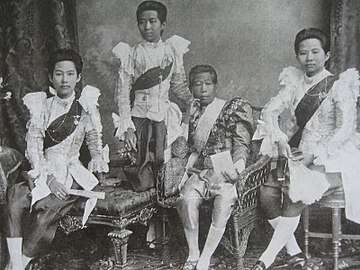
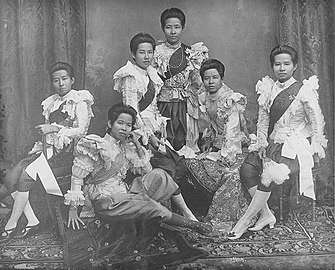
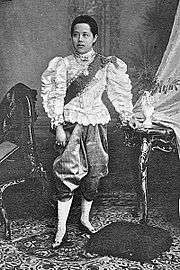

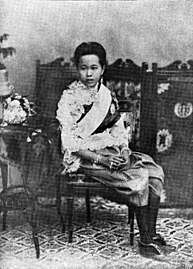
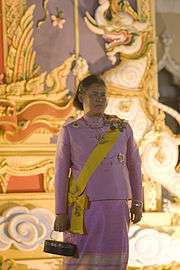
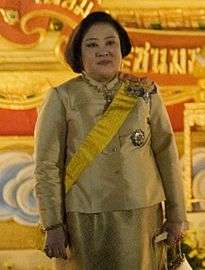
.jpg)